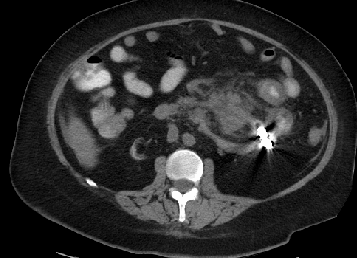History: 32 yo female. Remainder of history withheld.
Solution: The findings on these images allow you to recreate the history. Specifically, this is a patient with renal failure related to Type 1 Diabetes and associated renal transplantation (native renal atrophy and renal transplant in the RLQ). They subsequently developed post-transplant lymphoproliferative disorder (aneurysmal dilatation of the bowel with central cavitation and thick walls typical of lymphomatous involvement of the bowel). The patient presented with hematochezia and thus was given capsule endoscopies (x2) in order to identify the cause. These became lodged a the level of the PTLD and didn't pass. Although these represent B-cell proliferations and can resolve after decreasing immunosuppression, they can also become malignant lymphoma as well, which can be very difficult to treat because of the underlying transplant and associated issues.




